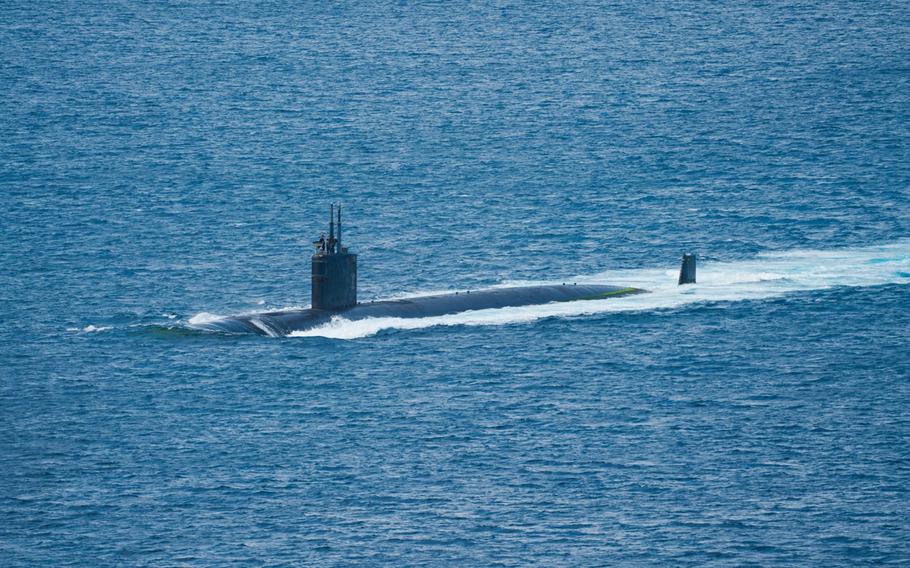
The Los Angeles-class fast-attack submarine USS Asheville transits Apra Harbor near Naval Base Guam, May 21, 2024. (James Caliva/U.S. Navy)
Allied firepower in the Western Pacific will get a significant boost with as many as five U.S. and British submarines operating from Australia by 2027, according to a report by an Australian think tank.
A 2021 pact by Australia, the United Kingdom and the United States — AUKUS — would position one British and four U.S. submarines as Submarine Rotational Force-West at naval base HMAS Sterling in Perth, Western Australia, according to the Australian Defence Department website.
The first phase of the defense pact is on track to bring the vessels to Australia on a temporary basis within three years, according to a report by Australia’s nonpartisan Lowy Institute.
“Deterrence and alliance power: Why the AUKUS submarines matter and how they can be delivered,” by former Australian assistant defense secretary Ross Babbage, was released July 29.
Combined with Australia’s Collins-class conventional subs and unmanned systems, the rotational force will make maritime challenges in the region “much more daunting” for China and other authoritarian states, the report states.
Additional nuclear-powered American and British attack and guided-missile submarines could bring the number of AUKUS boats in the Western Pacific to 12 or 13 by 2028, according to the report.
In a second phase of the pact, the U.S. plans to sell Australia at least three Virginia-class subs, and potentially two more, in the early 2030s.
Australia in the third phase would start building a new AUKUS-class submarine using a British design and U.S. technology. Australia expects the first of the new boats by the 2040s, when it would become the “future attack submarine” for the two Commonwealth countries.
Australian navy divers and their U.S. counterparts have already started training in Hawaii to support nuclear-powered subs, according to a May 22 U.S. Indo-Pacific Command news release.
“Having them here diving side-by-side with our guys, they get to see and understand the challenges of diving around a Virginia class submarine,” Chief Warrant Officer Michael Tuft, the command diving officer at the Pearl Harbor shipyard, said in the release.
The U.S. Navy is embedding Australian maintenance workers at the shipyard, Naval Submarine Forces commander Vice Adm. Robert Gaucher said in April, according to the Lowy report.
The U.S. may have subs in Australia within three years as it disperses forces to deter China, according to Carlyle Thayer, an emeritus professor at the University of New South Wales and a lecturer at the Australian Defence Force Academy.
The U.S. could transfer three to five Virginia-class subs to Australia in case of delays producing the AUKUS vessels, he said by email Thursday.
Boat transfers would depend on the U.S.’s ability to build more submarines, the geopolitical situation in the North Atlantic and Indo-Pacific and continued support for AUKUS by future U.S. administrations, Thayer said.
Australia has committed $662 million to constructing infrastructure needed for the U.S. and British subs Down Under, he said.
Delays may result if the British defense industry fails to meet deadlines, Australian labor and shipbuilding resources fall short, costs pile up or the Australians cannot recruit crews, he said.
Delays seem likely, Paul Buchanan, a U.S. security expert based in New Zealand, said by email Thursday.
“The US is already stretched to meet its sub-building requirements, as is the UK, so there will likely be delivery delays on the US and UK made components of the AUKUS platforms,” he said.
However, given the small number of Australian and allied subs deployed in the Western Pacific at any one time, an increase of just a few boats will amount to an increase in the 30% range, Buchanan said.
“The rotation of US and UK subs will accomplish that, and then the delivery of the first AUKUS subs next decade should boost the numbers even further,” he said.